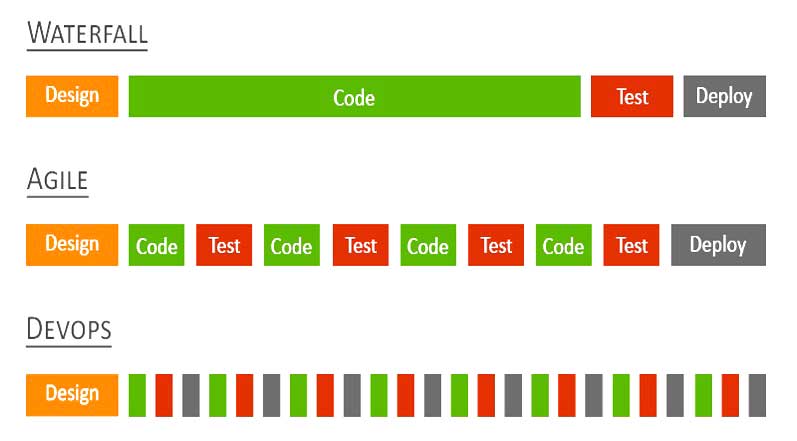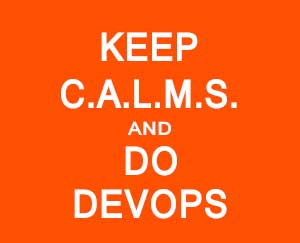What is DevOps ?

DevOps in simplest terms is “how you build and deploy your software”.
It is about the culture that your team members live, the principles that guide your development process, the set of practices you follow to automate and speed up your delivery, the mindset you demonstrate to achieve complete customer satisfaction.
We all know, the word DevOps is a shortened acronym of Development and Operations. In essence, it is bringing together your software development team and operations team to work towards a common goal and have a unified vision. Their collective focus is always the product or the application which is being developed, rather than individual performances or targets.
In the DevOps world, Dev and Ops don’t work in silos anymore, but rather work in collaboration, as a single unit more efficiently and effectively. They perform their specialized roles effectively, but possess an end-to-end visibility of the whole process. Blame-game is replaced by mutual admiration and celebration of each other’s success. Challenges are solved together and continuous and rapid software delivery becomes the ultimate aim.
The assured benefits of DevOps philosophy are rapid software releases, shorter development cycles, reduced risks, quicker issue resolution, and better productivity. DevOps is a logical extension to agile and the main force behind the dynamism exhibited by many tech-giants for their extraordinary high performance. Shared responsibility, agile processes, automated tasks, smarter workflows, fearless innovation and continuous feedback are the driving factors of a DevOps approach.
DevOps is definitely not about “unlearning” how you have been developing software, but it is about “learning the new dynamics of software development” – improvising the existing processes, prioritizing tasks, changing perspectives and looking at the larger picture from organization’s benefit rather than individual accomplishments.
A DevOps team will also begin from requirements and go until deployment, code and test software, but they will integrate and automate the steps to make the whole process seamless, faster and productive. Let us now understand each of these steps in detail.
- Continuous Development
- Continuous Testing
- Continuous Integration
- Continuous Deployment
- Continuous Monitoring
- Continuous Feedback
Still puzzled about
DevOps and its impact on your career?
Register for an upcoming course
Continuous Development
Software functionality is
implemented and the versions of code is maintained using
Version Control tools like Git, SVN, CVS etc.
Maintaining versions helps the
developers to collaborate on the latest committed code and
to rollback to previous versions in case of an unstable
deployment.
Continuous Testing
Automation Testing is an efficient
way to ensure code is thoroughly tested before it is
released to production. Tools like Selenium, TestNG,
Junit/NUnit are used to automate the test cases execution
which saves time and effort. Reports generated help in
defects analysis.
Triggering the entire automation
testing process is vital and hence, the Continuous
Integration tools come into the picture.
Continuous Integration
Developers commit their code after
each update, to a shared code base and each integration is
verified by an immediate build to minimize integration
errors. It is undoubtedly the most crucial phase of DevOps
cycle which holds it all together.
Popular tools are Jenkins, Bamboo
and Hudson where Jenkins is the most widely used. These
tools orchestrate the DevOps cycle.

Continuous Deployment
This is the phase where the code is
actually deployed in production-like environments.
Continuous Delivery is the process where new versions of an
application are deployed frequently. In Continuous
Deployment, we deploy each successful build to production
automatically.
Configuration Management and
Containerization tools that help in Continuous Deployment
are Puppet, Ansible, Chef, SaltStack, Docker etc.
Continuous Monitoring
Monitoring performance of an
application is as vital as its development. Defects that are
left during Testing phase have to be reported as bugs and
dealt with.
Splunk, ELK Stack, and Nagios are
some of the popular tools for monitoring. These tools help
you minimize the impact of failures.
Continuous Feedback
Feedback is the synergist for
organizational changes. DevOps feedback loop has transformed
the complete software delivery by highlighting all the major
issues and bottlenecks before the actual release. Feedback
is an integral part of the all phases.
Due to shorter development cycles,
we get frequent feedback from users which helps us to adapt
quickly to changing dynamics. Each time we integrate, we
test, or we deploy and run, the data we gather, are
important feedback mechanisms for constant
improvisation.
Every
organization must innovate and constantly improve to stay competitive in
this expeditious IT world. Whether you sell physical merchandise,
provide some online services, or deliver values through a web-based
application, your business definitely has to build some code, run it in
production and manage some IT infrastructure at an ever-growing
rate.
But how do you achieve this?
As we all know, there were many challenges with the conventional waterfall process. Software development and IT operations were two separate units that worked independently. Developers coded their pieces in secluded environments with unique configurations.
IT operations then took all the software artifacts and put them together as a running application in deployment that had desirable attributes such as high availability, scalability, and security.
Clients as well as production support were typically unaware of what the developers and testers were working on and if the business requirements changed midway, incorporating them within timelines and assuring quality was very difficult. The teams always blamed other counterparts for faults and failures.
With manual internal processes and workflows, productivity is always hampered by process bottlenecks or other dependencies.
Agile methodology could address some of these issues as it bridged the gap between developers and testers but Operations was still a separate entity, resulting in a huge delay in deployment. Agile made the development process faster through smaller and iterative deliveries, but there was a demand to reduce time-to-market and assure supreme quality.
DevOps was thus born, merging development and operations under one umbrella and significantly accelerating software delivery and offering incredible benefits.
DevOps owes its conception to Patrick Debois who coined the term ‘DevOpsDays’ for his conference in 2009 which emphasized on the power of different teams working together as ‘ONE’. Since then, started a new wave in technology and DevOps gradually became the IT buzzword which every organization wanted to adopt and experience.

rather
an essential element to compete and survive in the IT industry.
The following benefits from DevOps will help an organization appreciate the impact of a DevOps approach, such as:
- Accelerated Time to Market
- Shorter development cycles
- Effective communication and collaboration
- Improved Product Quality and Higher customer satisfaction
- Reduced Deployment Failures and Rollbacks
- Reduced Time to Recovery
- Reduced Costs
Benefits Explained
Accelerated Time to Market
01DevOps practices can minimize
confusion and delays occurring due to communication gaps.
The release frequency has increased dramatically. An
application now releases once a week on average compared to
once every one to six months, previously. Some applications
can be deployed multiple times in a day if needed.
The software development cycle
time until production has decreased from several months to a
few days. Companies gain advantage as they are able to
deliver business value to customers quicker. There is proven
data through reports that organizations which implement
DevOps principles, have 200x more frequent deployments, on
average and are able to achieve 2555x shorter lead times.
Shorter Development Cycles
02DevOps promotes a culture of increased collaboration and communication between the development and operations teams. This translates into shorter timeframes to move from engineering code into executable production code.
Effective Communication and Collaboration
03The team’s productivity increases multiple folds when all members target application/product performance rather than individual goals. Since there is mutual trust, they can share, experiment and innovate openly. The overall process becomes harmonious as all individuals work toward a unified vision.
Reduced Deployment Failures and Rollbacks
04Rapid development and deployment are
of no use, if the resulting release is a failure. But when
software is developed using a DevOps mindset, an operational
viewpoint is taken into account as well which minimizes
chances of such deployment failures. With improved defect
detection techniques, the number of pre- and post-deployment
issues and rollbacks, have decreased to a large
extent.
With substantial automation and
monitoring, DevOps teams can easily identify and eradicate
roadblocks and establish a more powerful and smooth release
process. Reports suggest that quick and structured responses
to unexpected production issues yield a 24x faster mean
time-to-recovery in organizations practicing DevOps and a 3x
lower change failure rate.
Improved Product Quality and Higher customer satisfaction
05One of the major reasons behind poor
quality products is programming defects. With shorter
development cycles and frequent code releases, it’s
easy to identify code defects. The CICD pipeline has
eliminated the errors that occurred due to manual
configurations and error-prone practices. Also, highest
priority incidents are a rarity now.
Frequent releases provide quicker
user feedback to the development teams. This lets them work
on only the useful features and build the right product. As
a result of constant feedback throughout the process, there
is faster identification of the capabilities customers care
about most, hence increased customer satisfaction.
Reduced Time-to-Recovery
06Even if the probability of failures
is minimized, failures will still occur. How well you bounce
back from a failure is what matters. The time to recover to
operational efficiency is reduced in a DevOps environment
compared to a traditional IT environment.
Recovery is much faster due to the
gained efficiencies as a result of effective communication
and better understanding across teams. The CICD pipeline
automatically rolls back an unsuccessful release. This
further reduces the risk of a release failure and makes it
more reliable.
Reduced Costs
07While measuring and quantifying
people’s behavior, in regards to DevOps, may be
difficult, it is still possible to measure tangible benefits
of DevOps such as an observed decrease in development and
operations costs.
Once organizations track the time
and cost for software application projects using a
traditional non-DevOps approach and compare it against using
DevOps, they will realize and better appreciate the
quantifiable benefits of DevOps.
Essential Elements
DevOps does not prescribe how it must be implemented to be effective. It is the perfect mix of the essential ingredients that makes DevOps practices fruitful.
Culture
DevOps culture is all about recognizing and valuing mutual success, collaboration, and joint responsibility. DevOps emphasizes on understanding others’ viewpoints and strongly believes in adjustments to accommodate others and collaborate with them, productively. For successful DevOps, all possible reasons of friction or misalignment, need to be proactively removed from the system.
Process
A communication channel is a must for manifesting a DevOps culture in practice where developers and IT operations can share expert ideas and together troubleshoot issues. So, a good and effective collaboration framework should be in place.
Well-defined contracts should be made which states that the configuration settings will remain same for dev, test, or production environments, hence removing environmental parity issues which often cause delays and failures.
Joint processes should be established like using a centralized repository to store software dependencies, always holding current data. With such mechanisms, it is feasible to push releases to production frequently and seamlessly, with minimal errors and downtime.
Automation Tools
Automation is at the heart of the DevOps approach. It is an important aspect that makes the process ‘lean’ as all repetitive tasks are automated and the risk due to human errors is also reduced. DevOps automation is vital to achieve agility. There are many tools involved in each phase of DevOps cycle which are rightly called the key enablers of DevOps.
There are multiple tool options available in the market to choose from, for various phases of DevOps – integrating these tools together to form an efficient CICD pipeline is the key to DevOps success.
A question that I am sure intrigues our mind often is – Why tools like Jenkins, Ansible, Chef, Puppet etc having been in existence for several years, did not get the traction that they have now? What is the reason behind their sudden popularity?
Individually, the tools may have lesser significance but in the DevOps context, they create a huge impact. CICD pipeline integrates them together for a bigger purpose – a common goal, making them extremely relevant and useful.
No wonder, organizations typically spend around 73 percent of their DevOps budget in tool acquisition. It is best to have a tools strategy that adheres to a common set of objectives while providing seamless cross-tool collaboration and integration.
No single tool will satisfy the needs of every project, but with so many high-quality open source solutions available in the market, there’s a fair possibility that you will be able to find a combination that is a viable fit for your requirements.
While some organizations may debate over the importance of Automation tools over people for DevOps success, people and automation tools both are the pillars of DevOps philosophy and it is the perfect combination of both that will lead to effective DevOps implementation.

- Respect the CULTURE by respecting each other
- AUTOMATE wherever possible to eliminate error
- Perfect process and eliminate wastage through LEAN practices
- MEASURE progress
- SHARE feedback freely without blame
Request A Batch
Register for an
upcoming course and get complete clarity on DevOps
Pitfalls to Look Out For
Here are some of the points that you must consider and proactively handle, to reduce the number of challenges you face, during the implementation of DevOps practices. The key to improving how the world builds software is solving both hard technical and organizational challenges.
Don't misinterpret Devops
People often misunderstand the true
meaning of DevOps. It takes a while for people to truly
realize the motto behind DevOps and the appreciate the
benefits it offers.
DevOps never advocates that every team member should be
capable of doing everything. Rather, it emphasizes that team
members accomplish their individual tasks and collaborate
effectively to meet team goals.
Always Customize as Per Requirements
DevOps practices should always be structured to meet the unique needs of the organization, taking into account several parameters like organizational structure, team incentives, current software life cycle, sources of delay, and opportunities for automation. At the same time, accountability, transparency, and continual learning should not be compromised.
Inadequate Foresight is Not Good
Lack of vision makes it challenging for project owners to create a clear plan about estimates, milestones, and deliverables. Since DevOps is relatively new, it is difficult to find members who have adequate expertise in this field. Due to this, most of the roadblocks are intimidating for organizations which follow a streamlined set of guidelines.
Insufficient Tool Knowledge
People working on legacy tools
prefer to continue them, as getting familiar with the
functionalities of the latest tools is often a tough task. A
shortage of tool knowledge and the technology behind it,
often leads organizations into making incorrect choices of
tools that would best align with their technical
vision.
Proper cross-tool collaboration
and integration is also difficult to achieve, with
incomplete knowledge about tools.
It's all about Teamwork
People are always reluctant to
change, hence it is difficult to adapt easily to the
cultural shift DevOps brings. As DevOps focuses heavily on
collaboration, each member must be ready to share
responsibility and look beyond his own boundaries of
work.
Without a harmonious outlook, even
the best of tools will not be effective. Automation tools
are a must for quicker deliveries but the foremost step in
succeeding with DevOps is creating a cross-functional team
guided by empathy, transparency, respect, and aligning
towards a common goal.
Avoid Unnecessary Complexity – Integrate Cautiously
Keep things simple and integrate
cautiously
Too many vendor solutions in the market, lead to huge
confusion and often result in significant overhead and
complexity. Ideally, all teams across organizations should
adhere to a standardized tool stack and a unified approach.
This will surely smoothen your DevOps implementation.
Understanding DevOps is an expedition
A shift to DevOps culture is
comparatively easier for small companies like startups than
for larger organizations. It is best to take an incremental
approach, slowly introducing DevOps to bring out changes in
people’s behavior and maximize chances of acceptance.
DevOps practices must be dynamic
and grow along with the evolving requirements, to fulfill
its purpose of enhancing the software delivery
experience.

